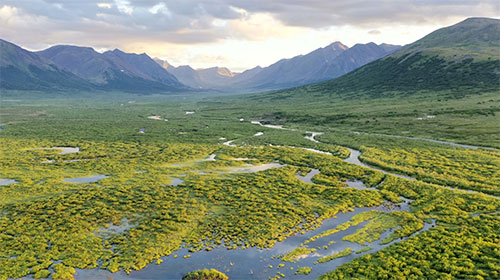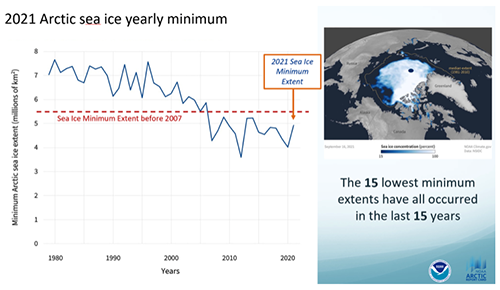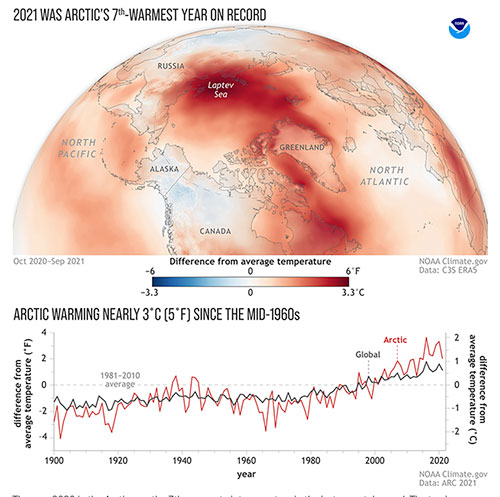As Arctic tundra warms and thaws, incursions of shrubs and small trees have created new habitat for beaver, which create ponds and wetlands that further transform the once-frozen landscape. |
“The Arctic Report Card continues to show how the impacts of human-caused climate change are propelling the Arctic region into a dramatically different state than it was in just a few decades ago,” said NOAA Administrator Rick Spinrad, Ph.D. “The trends are alarming and undeniable. We face a decisive moment. We must take action to confront the climate crisis.”
The Arctic Report Card is organized into three sections. Vital Signs provides annual updates on seven topics: Surface Air Temperature; Terrestrial Snow Cover; Greenland Ice Sheet; Sea Ice; Sea Surface Temperature; Arctic Ocean Primary Productivity; and Tundra Greenness. Other Indicators explore topics that are updated periodically. Frostbites report on new and emerging issues, and topics that relate to long-term scientific observations in the Arctic.
The minimum sea ice extent measured in September didn’t set a record, but was still significantly below the long-term average. More concerning: the amount of older, multiyear ice was the second lowest since 1985. |
Some of this year’s significant findings include:
- The October-December 2020 period was the warmest Arctic autumn on record dating back to 1900. The average surface air temperature over the Arctic this past year (October 2020-September 2021) was the 7th warmest on record. The Arctic continues to warm more than twice as fast as the rest of the globe.
- The snow-free period across the Eurasian Arctic during summer 2020 was the longest since at least 1990. June 2021 snow cover in Arctic North America was below the long-term average for the 15th consecutive year. June snow cover in Arctic Europe has been below average 14 of the last 15 years.
- Following decades of relative stability, the Greenland ice sheet has now lost mass almost every year since 1998, with record ice loss in 2012 and 2019. In August, rainfall was observed at the Greenland ice sheet’s 10,500-foot summit for the first time ever.
- The volume of post-winter sea ice in the Arctic Ocean in April 2021 was the lowest since records began in 2010. The amount of older, biologically important multiyear sea ice at the end of summer 2021 was the second-lowest since records began in 1985.
- The total extent of sea ice in September 2021 was the 12th lowest on record. All 15 of the lowest minimum extents have occurred in the last 15 years. The substantial decline in Arctic ice extent since 1979 is one of the most iconic indicators of climate change.
- The loss of sea ice has enabled shipping and other commercial and industrial activities to push deeper into the Arctic, in all seasons, resulting in more garbage and debris collecting along the shore and more noise in the ocean, which can interfere with the ability of marine mammals to communicate.
- Some of the fastest rates of ocean acidification around the world have been observed in the Arctic Ocean. Two recent studies indicate a high occurrence of severe dissolution of shells in natural populations of sea snails, an important forage species, in the Bering Sea and Amundsen Gulf.
The year 2020 in the Arctic saw the 7th warmest air temperature in the instrumental record. The top image depicts the departure from the average temperature across the Arctic in 2020, with redder colors showing areas of greater warmth. The bottom half of this graphic shows how Arctic air temperatures varied from global temperatures since 1900. |
“The Arctic story is a human story,” said Twila Moon, an Arctic scientist with the National Snow and Ice Data Center, and one of three editors of the 2021 Arctic Report Card. “We all have a role to play in creating the best possible outcomes for the region, its residents and all the citizens of the globe who depend on the Arctic as a critical component of our Earth system.”
Watch the Video Summary of the 2021 Arctic Report Card |
On the Web:
Download & Read NOAA's 2021 Arctic Report Card (119 pages)
Edited By: Mary Kauffman, SitNews
Source of News:
NOAA
www.arctic.noaa.gov
Representations of fact and opinions in comments posted are solely those of the individual posters and do not represent the opinions of Sitnews.
Send a letter to the editor@sitnews.us
SitNews ©2021
Stories In The News
Ketchikan, Alaska
Articles & photographs that appear in SitNews are considered protected by copyright and may not be reprinted without written permission from and payment of any required fees to the proper freelance writers and subscription services.
E-mail your news & photos to editor@sitnews.us
Photographers choosing to submit photographs for publication to SitNews are in doing so granting their permission for publication and for archiving. SitNews does not sell photographs. All requests for purchasing a photograph will be emailed to the photographer.



